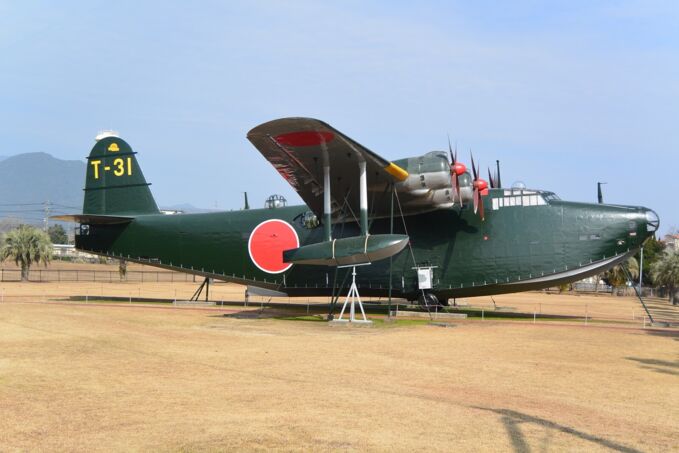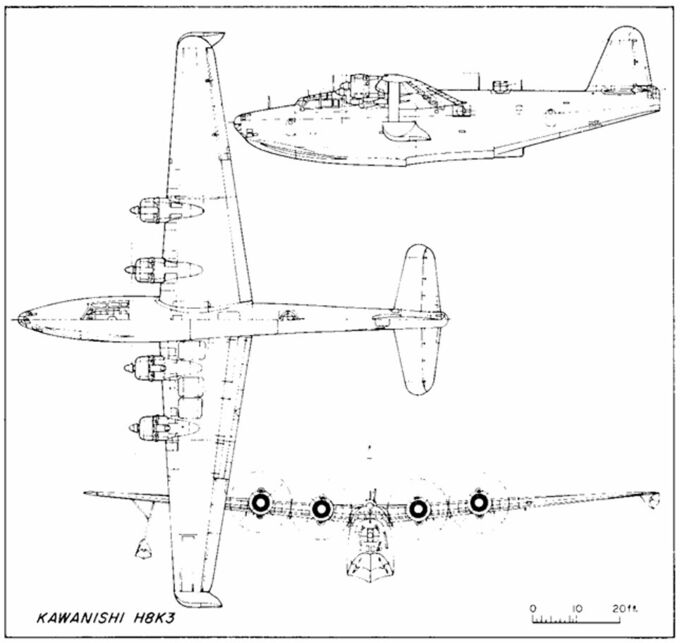The Kawanishi H8K flying boat, developed under the Navy Experimental 13-Shi Large Flying Boat specification, was a remarkable achievement of Japanese aeronautical engineering during World War II. It was intended to surpass the capabilities of earlier models like the Navy Type 97 Flying Boat, as well as contemporary Allied designs like the Short Sunderland and Sikorsky XPBS-1.
It possessed a top speed of 240 kt (276 mph), a cruising speed of 180 kt (207 mph) and a maximum patrol range of 4,500 naut miles (5,180 st miles). To meet its extraordinary range requirements, the H8K featured eight unprotected wing fuel tanks and six large hull tanks. The hull tanks were partially self-sealing and equipped with a carbon dioxide fire extinguisher system and a clever drainage system ensured that punctured fuel could be pumped back into intact tanks, reducing fuel loss in combat scenarios. The total fuel capacity was 17,040 liters (3,749 imperial gallons), with fuel weight accounting for 29% of the aircraft’s maximum weight.
The aircraft was a high-wing cantilever monoplane, designed for aerodynamic efficiency and operational robustness. Extensive wind tunnel and water tank testing informed the sleek design of both the hull and wing structures, ensuring low drag and excellent hydrodynamic performance.
H8K1 Prototype
The H8K1 prototype, completed in December 1940, was designed with extensive armor protection and a defensive armament system that included multiple 20 mm cannons and 7.7 mm machine guns strategically placed in various turrets and hatches.
The aircraft was powered by four Mitsubishi MK4A Kasei 11 radial engines, each producing 1,530 horsepower, and equipped with four-blade propellers. After its maiden flight in January 1941, the prototype faced significant problems during takeoff, as it was highly unstable once the nose was lifted. This caused water to be thrown into the propellers and over the wings, creating a dangerous situation.
To address these issues, the aircraft was sent back to the factory for modifications. The hull depth was increased by 50 cm, the planing bottom was adjusted, and longitudinal steps were added to the hull’s forward portion. After these changes, the aircraft’s water-handling capabilities improved, although still not as effective as the H6K series. However, its overall flight performance and handling were significantly better than its predecessor, offering hope for its future operational success.
Production H8K1
Late in 1941, following the results of the service trials, the Japanese Navy approved the production of the aircraft, naming it the Navy Type 2 Flying Boat Model 11 (H8K1). By then, two pre-production aircraft had already been flown, with the second incorporating the modified vertical tail surfaces that would be standard on all production models.
The H8K1 was powered by four Mitsubishi MK4A Kasei 11 or MK4B Kasei 12 radial engines, each producing 1,530 horsepower. The aircraft’s defensive armament was reduced compared to the prototype, consisting of two 20 mm Type 99 Model 1 cannons in the dorsal and tail turrets, and four flexible 7.7 mm Type 92 machine guns in various positions.
For its offensive payload, the H8K1 could carry either two 800 kg torpedoes, eight 250 kg bombs, or other ordnance depending on the mission requirements.
First Combat Mission
The H8K1's first combat mission took place on the night of March 4–5, 1942, when two aircraft from the Yokohama Kokutai, based at Wotje Atoll in the Marshall Islands, attacked Oahu Island after being refueled by a submarine at French Frigate Shoals.
Unfortunately, due to heavy cloud cover in Honolulu, the mission did not yield significant results. Another mission, timed to coincide with the Japanese attack on Midway, was canceled when the refueling submarine found the US forces had occupied French Frigate Shoals. Despite these setbacks, the H8K1 proved highly effective in its intended maritime reconnaissance role. Its robust defensive armament, strong armor, fuel tank protection, and high speed made it capable of defending itself in hostile environments.
H8K2
The H8K1 was eventually surpassed by the H8K2 Model 12. Powered by four 1,850 hp Mitsubishi MK4Q Kasei 22 engines with water injection, the H8K2 featured improved performance. This modification, which had first been tested on the H8K1 prototype, provided such a boost that Kawanishi transitioned to producing the H8K2 after only sixteen of the earlier H8K1 models had been built.
The new engines allowed the aircraft’s maximum take-off weight to be increased from 31,000 kg to 32,500 kg, and the fuel capacity was expanded to 18,880 liters. Despite the modifications, the H8K2 remained externally similar to the H8K1, though its vertical tail surfaces were adjusted once again.
The H8K2 was equipped with revised defensive armament, which retained the original features but added a flexible 7.7 mm Type 92 machine gun in the cockpit sides. The H8K2 became known for being the most heavily defended and fastest flying boat of its time, earning the respect of Allied fighter pilots who found it difficult to shoot down.
Introduction into Service
Introduced in 1943, the H8K2 replaced the older Navy Type 97 Flying Boat, as well as its first version (H8K1), as Japan’s primary long-range maritime reconnaissance aircraft. Many of the later H8K2s were fitted with ASV radar, and the aircraft remained in service with frontline units until Japan’s surrender.
The original H8K1 prototype, after serving as an engine testbed for the Kasei 22 engine, was further modified into a transport version. This new version featured a deep hull with two decks: the lower deck stretched from the nose to the rear hull step, and the upper deck extended from the wing center-section, making the aircraft suitable for transport missions.
The H8K2-L Model 32, also known as the Navy Type 2 Transport Flying Boat Seiku, was a modified version of the H8K2 designed for transport missions. The aircraft featured a two-deck cabin that could accommodate either twenty-nine passengers or sixty-four troops. The addition of the lower deck cabin led to the removal of most of the fuel tanks, reducing the total fuel capacity to 13,414 liters.
The armament was simplified, with only a 13 mm Type 2 machine-gun in the nose turret and a 20 mm Type 99 Model 1 cannon in the tail turret. After successful flight trials, the transport variant was delivered to the Naval Headquarters at Yokosuka, where it was used as a staff transport.
Production of the H8K2-L was authorized, and between 1943 and 1945, thirty-six units were built, all of which were operated by Naval transport units.
Initially, the H8K was designed with retractable stabilizing floats, but these were discarded in favor of fixed floats to reduce weight. However, in 1943, the idea of retractable floats was revisited as a means of increasing the aircraft’s top speed. By 1944, two Kasei 22-powered prototypes with retractable stabilizing floats were completed, further modifying the aircraft for improved performance.
More Models and Prototypes
The H8K3 Model 22 was an upgraded version of the H8K2, undergoing extensive flight testing with several key modifications. It retained the same defensive armament as the H8K2, but featured sliding hatches instead of the side blisters, a change that was later adopted for late-production H8K2s. Additionally, the H8K3 replaced the non-retractable dorsal turret with a fully retractable one.
In 1945, the two H8K3 prototypes were re-engined with Mitsubishi MK4T-B Kasei 25b radials, resulting in the redesignation of these aircraft as the H8K4 Model 23. However, neither the H8K4 Model 23 nor its planned transport version, the H8K4-L Model 33, went into production. By this point, the Japanese Navy’s priority had shifted to interceptor fighters, leading Kawanishi to focus on the production of the N1K2-J Shiden Kai.
Despite the limited number of H8K aircraft, the Japanese flying boat emerged as one of the most formidable water-based combat aircraft of World War II, thanks to its exceptional design and performance. The H8K became one of the most advanced and capable flying boats of its era. Its combination of speed, range, and durability made it a valuable asset in maritime reconnaissance and long-range patrols.
- Francillon, René J. Japanese Aircraft of the Pacific War. London: Putnam & Company, 1970 (2nd edition 1979). ISBN 978-0-370-30251-5.
- Millot, Bernard (July 1976). “Kawanishi H8K ‘Emily’, le seul bombardier stratégique capable d’aller jusqu'à Pearl Harbor (3)” [The Kawanishi H8K Emily: The Only Strategic Bomber Capable of Reaching Pearl Harbor, Part 3]. Le Fana de l’Aviation (in French) (80): 16–19. ISSN 0757-4169.
- Richards, M. C. (1972). Kawanishi 4-motor Flying-boats (H6K 'Mavis” and H8K 'Emily'). Profile Publications.
For pictures:
- [MediaWiki Commons] Kawanishi H8K (and subcategories)











